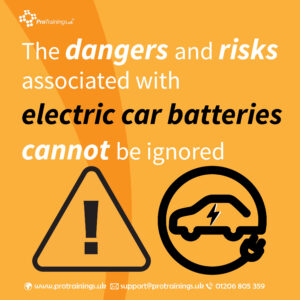The Dangers of Electric Car Batteries: A Focused Analysis
Electric vehicles (EVs) are rapidly gaining popularity as a cleaner alternative to traditional petrol and diesel cars. Central to their operation are lithium-ion batteries, which store the energy required to power the vehicle. However, while these batteries are a cornerstone of the electric car revolution, they also pose several significant dangers and risks that are often overlooked. This article delves into the specific hazards associated with electric car batteries and offers guidance on what to do if you encounter an EV involved in an accident.
1. Fire Risks and Thermal Runaway
One of the most critical dangers associated with electric car batteries is the risk of fire. Lithium-ion batteries, commonly used in EVs, are prone to a phenomenon known as thermal runaway. This occurs when the battery overheats, leading to a chain reaction that generates more heat, potentially resulting in a fire or explosion.
In the event of a collision, the integrity of the battery pack can be compromised, increasing the likelihood of a fire. Unlike fires in conventional vehicles, which are generally easier to extinguish, battery fires are notoriously difficult to control. They can reignite hours or even days after the initial fire has been put out, posing ongoing risks to vehicle occupants, first responders, and nearby structures.
2. Toxic Exposure and Environmental Hazards
When an electric car battery catches fire or is improperly disposed of, it can release toxic chemicals into the environment. The combustion of lithium-ion batteries produces hazardous substances such as hydrogen fluoride, which can cause severe respiratory issues and other health problems.
Additionally, in the event of a fire, the smoke generated by burning batteries can contain toxic gases that pose serious health risks to anyone exposed, including firefighters and bystanders. The environmental impact of these toxic releases is also a concern, as they can contaminate air, water, and soil.
3. Battery Degradation and Safety Risks
Over time, the performance of lithium-ion batteries degrades, reducing their efficiency and driving range. As batteries age, the risk of malfunction increases, potentially leading to overheating or other failures. Degraded batteries are more prone to developing internal short circuits, which can trigger thermal runaway and subsequent fires.
This degradation process also presents a challenge when repurposing or recycling old batteries. If not handled correctly, aged batteries can be unstable and dangerous, leading to accidents during transportation, storage, or disposal.
4. Challenges in Firefighting and Emergency Response
The unique nature of electric car battery fires presents significant challenges for emergency responders. Traditional firefighting techniques are often insufficient to tackle lithium-ion battery fires, which may require large quantities of water or specialised fire suppression systems. In some cases, fire departments have had to resort to submerging the entire vehicle in water to fully extinguish the fire.
Furthermore, the high-voltage systems in electric vehicles add another layer of risk for first responders. Without proper training and equipment, there is a danger of electric shock when attempting to access the battery pack or cut through the vehicle to rescue occupants.
What to Do If You Encounter an EV Involved in an Accident
If you come across an accident involving an electric vehicle, it’s essential to take specific precautions to ensure your safety and that of the occupants. Here are some key steps to follow:
-
Assess the Situation from a Distance:
- Before approaching the vehicle, observe it from a safe distance. Look for any signs of smoke, sparks, or unusual sounds that could indicate a battery fire or thermal runaway. If you notice any of these signs, stay back and call emergency services immediately.
-
Turn Off the Vehicle:
- If it is safe to do so, and you are familiar with the controls, try to turn off the vehicle to deactivate the high-voltage system. Most EVs have a clearly marked “Emergency Cutoff” switch or button, often found near the driver’s seat or in the boot.
- If it is safe to do so, and you are familiar with the controls, try to turn off the vehicle to deactivate the high-voltage system. Most EVs have a clearly marked “Emergency Cutoff” switch or button, often found near the driver’s seat or in the boot.
-
Avoid Touching the Battery or High-Voltage Components:
- Do not attempt to touch or tamper with the battery or any high-voltage components. Even if the vehicle appears inactive, the battery may still carry a significant charge that can cause electric shock.
-
Assist the Occupants:
- If the vehicle is not showing signs of fire or electrical hazards, carefully assist the occupants in evacuating the vehicle. Be cautious when opening doors or touching metal parts, as they could be electrified in the event of a severe battery malfunction.
-
Warn Others:
- Alert other bystanders to the potential dangers of approaching the vehicle. Make sure they are aware of the risks associated with battery fires and electric shock.
-
Wait for Professional Assistance:
- Once the occupants are safely out of the vehicle, wait for professional emergency responders to arrive. Inform them that the vehicle involved is electric so they can take the appropriate precautions.
Conclusion
Electric car batteries are a crucial component of the shift towards more sustainable transportation. However, the dangers and risks associated with these batteries cannot be ignored. From the immediate threat of fires and toxic exposure to the long-term challenges of degradation and emergency response, it is clear that more attention must be paid to the safety and sustainability of electric vehicle batteries. If you encounter an EV involved in an accident, understanding the specific risks and knowing how to respond safely is vital to ensuring the safety of everyone involved.





